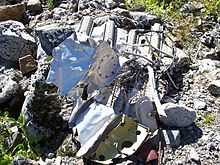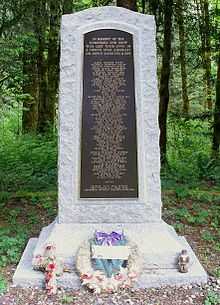Trans-Canada Air Lines Flight 810
|
A TCAL Canadair North-Star | |
| Accident summary | |
|---|---|
| Date | 9 December 1956 |
| Summary | Crash (CFIT) |
| Site | Mount Slesse, near Chilliwack, British Columbia, Canada |
| Passengers | 59 |
| Crew | 3 |
| Injuries (non-fatal) | 0 |
| Fatalities | 62 (all) |
| Survivors | 0 |
| Aircraft type | Canadair North Star |
| Operator | Trans-Canada Airlines |
| Registration | CF-TFD[1] |
Trans-Canada Air Lines Flight 810 was a Canadair North Star on a scheduled flight from Vancouver to Calgary (continuing to Regina, Winnipeg, and Toronto). The plane crashed into Mount Slesse near Chilliwack, British Columbia, Canada, on 9 December 1956 after encountering severe icing and turbulence over the mountains. All 62 people on board died, making this one of the worst airline crashes in the world at that date;[2] it still ranks as the sixth worst air disaster in Canadian history.[1]


Due to the remoteness and difficulty of the terrain, the crash site was not located until the following May, when it was discovered by mountaineers Elfrida Pigou, Geoffrey Walker, and David Cathcart.[3] Among the victims were five professional Canadian football players on their way home from the annual Shrine Game between the East and West all-stars in Vancouver.
The remains are located in a highly inaccessible area and are protected from disturbance.[4]
Summary of events
Flight 810-9 left Vancouver International Airport at 6:10 PM on 9 December 1956, assigned to fly the Green 1 air lane east to Calgary, Alberta, though the pilots asked for and received clearance for a routing via airways Red 44 and Red 75 instead, which took the aircraft past Cultus Lake and into a weather system called a trowal. The pilots climbed to 19,200 feet (5,900 m) by 6:55, when they experienced a fire warning indication in No. 2 (the inner port engine), which was then shut down as a precaution (false fire warnings in Northstar aircraft had been noted on numerous previous occasions.) They radioed Vancouver Air Traffic Control to notify them of the event ("looks like we had a fire"), requested a return flight path on Airway Green 1 back to Vancouver Airport (the flight path with the most favourable terrain for an aircraft losing altitude), but inexplicably made a left turn instead of a right one and wound up heading west-southwest 12 miles (19 km) south of Green 1 and straight into the border mountains.
At 7:10, the plane radioed that they were passing Hope, and was given clearance to descend to 8,000 feet (2,400 m). This was the last communication received from the plane. The plane was also being tracked by an American radar installation in Birch Bay, Washington, throughout most of its flight after turning around, but at 7:11 pm the station lost track of Flt. 810 in the vicinity of 8,530-foot (2,600 m) Mt. Silvertip just east-northeast of where the plane went down moments later.
The cause of the crash is given in the official report as being the combination of several factors with the main ones being icing of the wings and fuselage and the loss of No. 2 engine, but many questions remain, including why the aircraft turned away from Green 1 rather than toward it (and reporting to ATC that it was on Green 1), and why this was picked up by neither the pilot nor First Officer despite spirit compasses and several radio aids-to-navigation on board which should have made the error rather obvious.
As the aircraft flew straight into the third peak of Mt. Slesse well in excess of cruising speed – and crashed in remote and dangerously inhospitable territory – very little information could be gleaned from the wreckage itself as to the cause of what was then the worst aircraft calamity in Canadian history. The wreckage and remains of the passengers and crew were left on the mountain at the crash site (though body parts found during the Coroner's inquiry were interred in two common graves on the mountainside), and despite years of erosion and avalanche, remains of the aircraft can be seen to this day.
Victims

All three crew and 59 passengers were killed; among the victims were five professional Canadian football players on their way home from the annual East–West all-star game in Vancouver.[5][6]
- Notable passengers
- Melvin Howard Becket, player with the Saskatchewan Roughriders
- Mario Joseph DeMarco, former National Football League player, player with the Saskatchewan Roughriders
- Calvin Jack Jones, player with Winnipeg Blue Bombers
- Gordon Henry Sturtridge, player with the Saskatchewan Roughriders
- Raymond Nicholas Syrnyk, player with the Saskatchewan Roughriders
| Nationality | Crew | Passengers | Total |
|---|---|---|---|
| |
3 | 44 | 47 |
| |
– | 4 | 4 |
| |
– | 2 | 2 |
| |
– | 9 | 9 |
| Total | 3 | 59 | 62 |
See also
Notes
- ↑ 1.0 1.1 ASN Database
- ↑ O'Keefe and MacDonald, p 146
- ↑ O'Keefe and MacDonald, p. 93
- ↑ MeClement, Fred (14 July 1962). "The Strange legacy of flight TCA flight 810's crash on Mt. Slesse on 9 December 1956 between Vancouver and Calgary". Maclean's (Toronto Maclean-Hunter Limited). in: Michael Benedict (ed.). In the Face of Disaster. Viking. pp. 277–289. ISBN 0-670-88883-4.
- ↑ McNeil, Shane (2 November 2012). "Engraved on a Nation: A Family United Through Tragedy". The Sports Network. Retrieved 2 November 2012.
- ↑ Beamish, Mike (1 November 2012). "Fatal 1956 CFL air crash-Engraved on a Nation: Recalling a flight taken, and not taken". The Vancouver Sun. Retrieved 2 November 2012.
References
- O'Keefe, Betty and MacDonald, Ian, Disaster on Mount Slesse, Caitlin Press, 2006, ISBN 1-894759-21-4
- Accident description at the Aviation Safety Network
| ||||||||||
